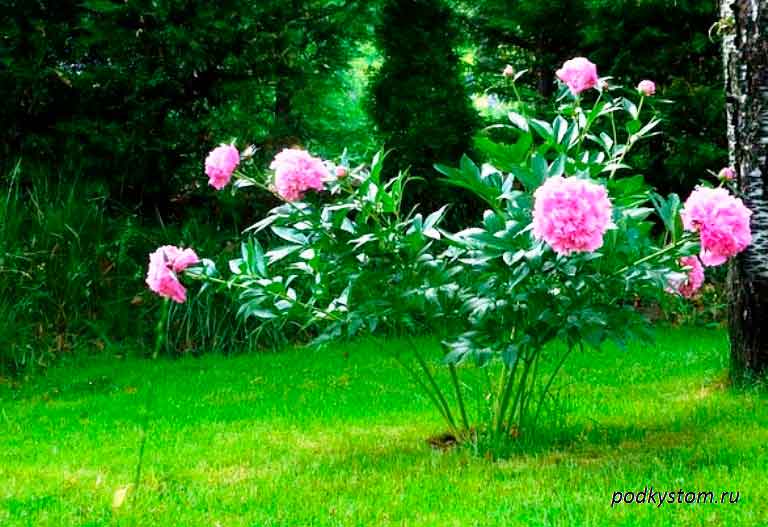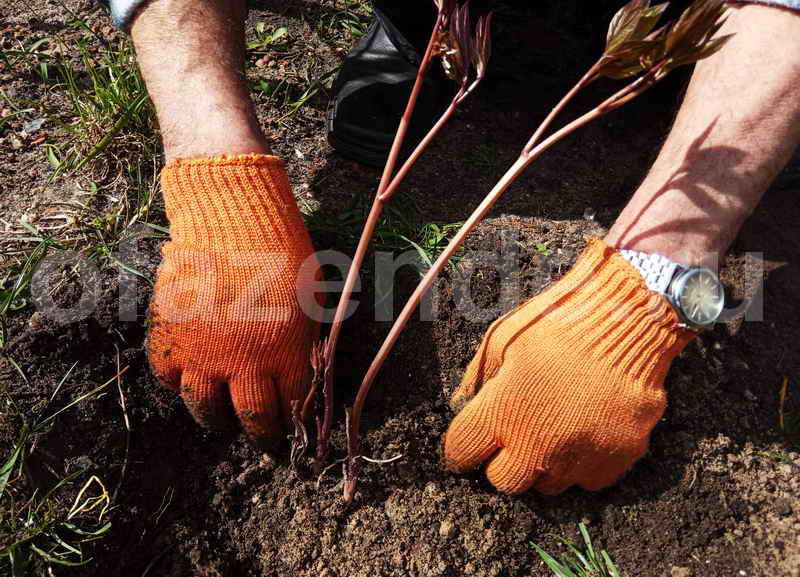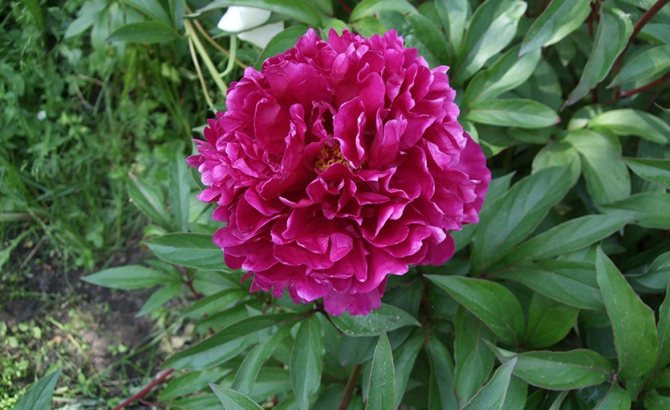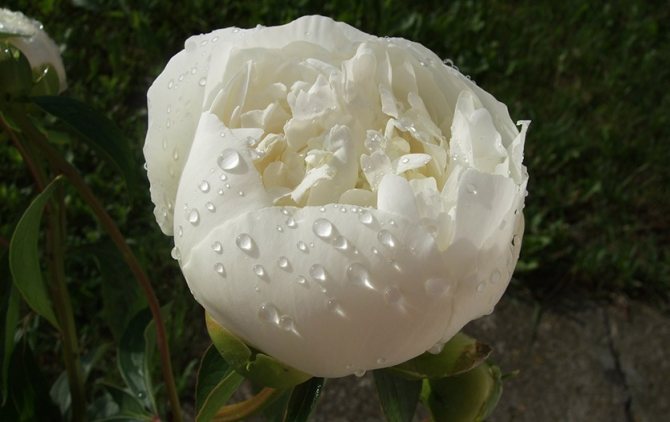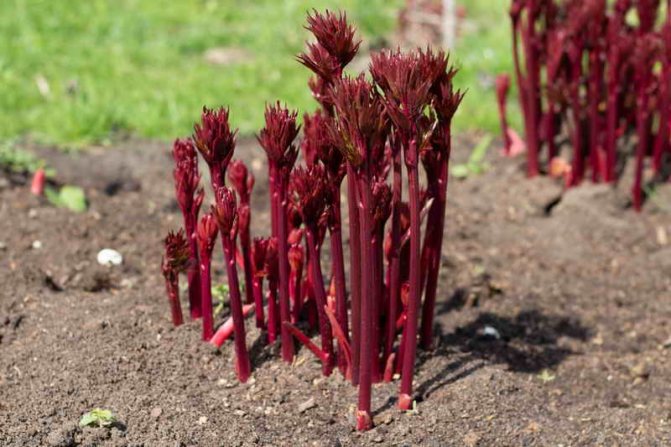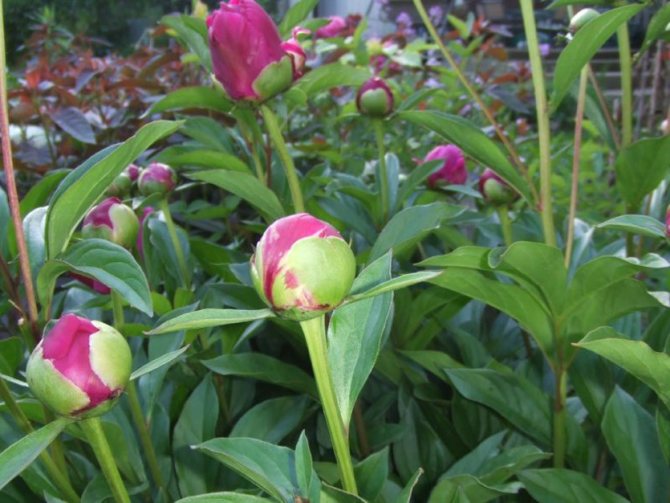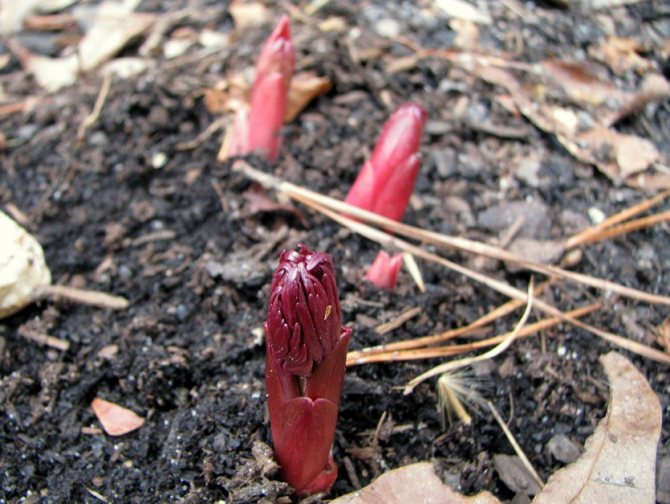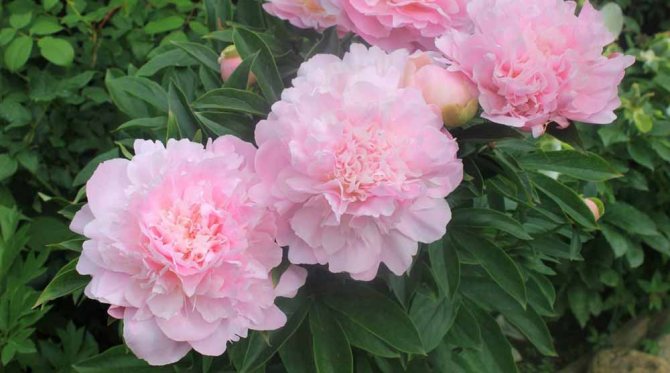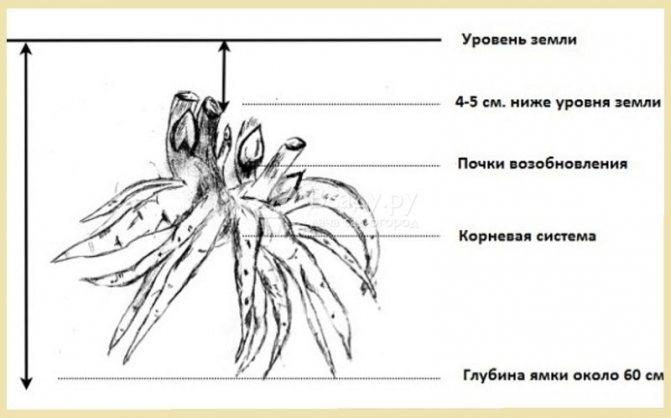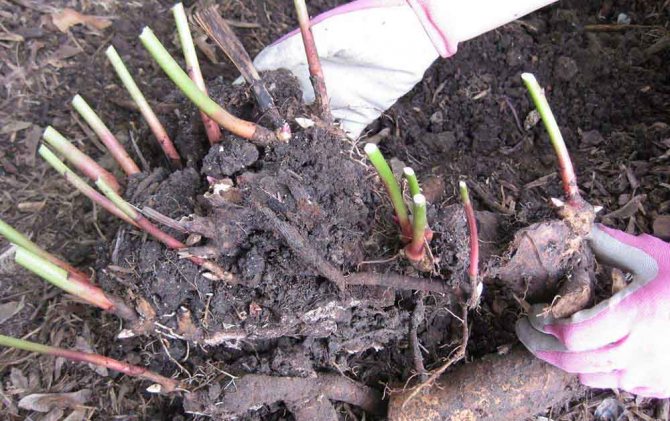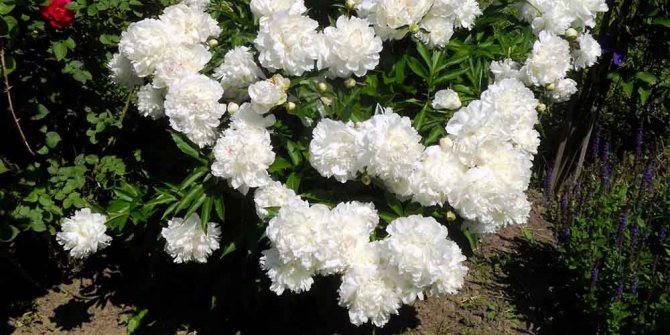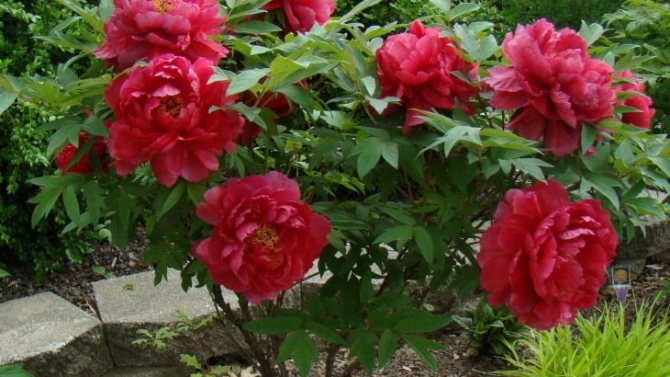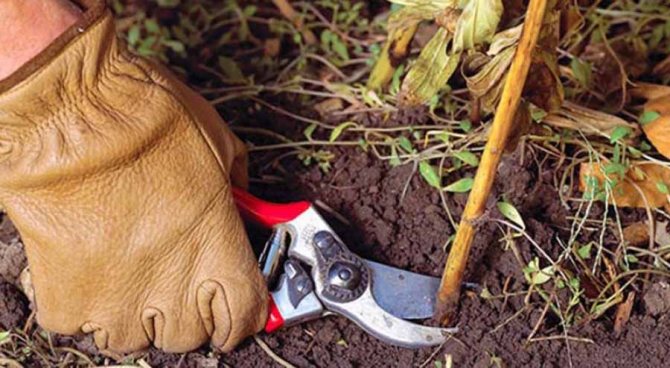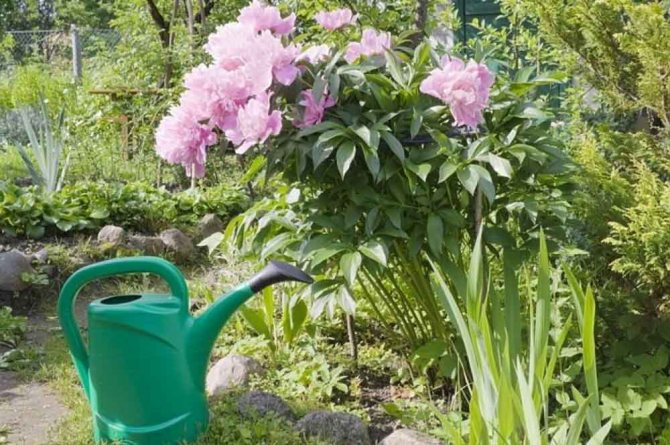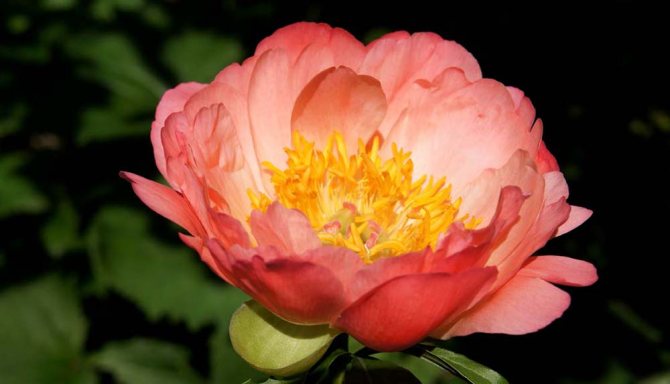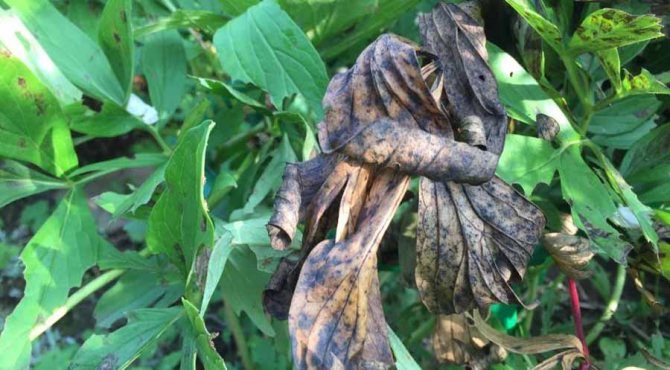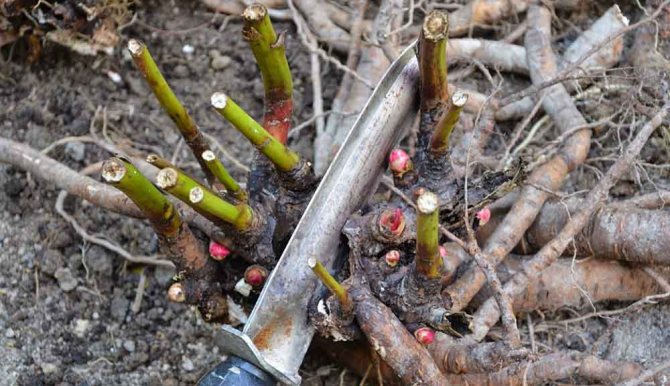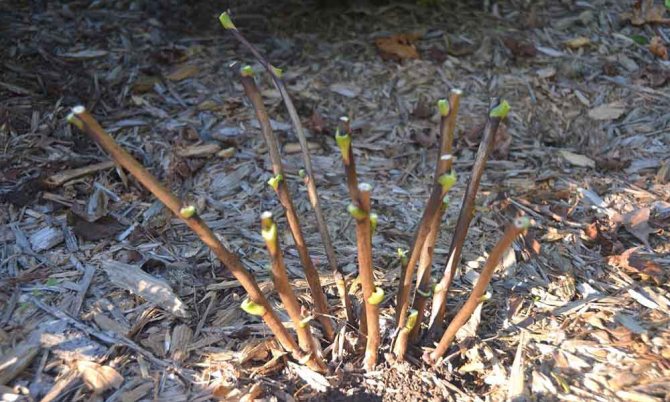Peonies, their planting and care in the open field does not cause any particular difficulties, since these flowers grow well on any soil. However, for abundant flowering, they should still be provided with optimal care, which includes regular watering, fertilizing and loosening the soil.
How to properly plant peonies of various varieties and care for them in spring and autumn, you will learn from this article. It provides advice from experienced florists and helpful tips to help keep your plants healthy and blooming.
- Where to begin
- Watering
- Planting a tree peony in spring: video
Reproduction by dividing the bush
The main cultivation method is the division of root tubers. Plants that have reached 8-10 years are already ready for this. The process itself requires a significant investment of labor and time from us, but everyone can do it.
As a rule, a peony grows and blooms in one place for about 10-15 years. We subject the old rhizome to division, which serves as a rejuvenating and healing procedure for the culture.
A convenient time to increase the number of culture is mid-August.
Our actions.
We start by carefully digging out the root tubers, protecting them from damage. We pay special attention to small young roots growing from the rhizome. To do this, having dug in the bush to a depth of 30 cm, slowly swing it with a crowbar (shovel), and then carefully pull it out of the hole.
Next, we need to clear the tubers from the ground. Well, if the soil at the time of work is dry enough, light enough, then we just shake them gently. But if the ground is wet, heavy, take a hose (you can use a watering can without a diffuser) and wash it with water. Having freed from the soil, we leave it alone in the air for 2-3 hours. We need this time in order for the roots to wither a little and lose their fragility.

Finally, we proceed directly to the division into small parts. But first, we cut off the stems of the plant, leaving no more than 10-12 cm from the surface. In the further process, you should not hold on to them, since they break easily, and there are buds in their bases. And throwing them on the ground is also not worth it, because this can lead to fragments of roots and buds.
We choose a place on the bush with the smallest number of buds, take a strong wooden peg or something similar, and drive it in there. First, with its help, we tear the bush into two halves. But further, each half, taking a well-sharpened garden knife, we divide into large, and then gradually into small parts. As a result, delenki for planting, representing part of the root tubers, should have three or more rather large buds.
Having divided the bush, we carefully examine all the resulting parts for unhealthy, old, rotting elements. If any are found, we remove them by trimming them to strong, healthy tissue that has a white color. The surface of the cut is subject to mandatory processing with the help of powder from crushed coals or wood ash, so as not to give an unnecessary reason for decay.
How to plant
When planting peonies in open ground, it is necessary to choose the right timing, prepare the place and soil, and also follow a certain pattern.
Timing
Peonies are planted in autumn or spring. Each case has its own characteristics.
In autumn
The period from late August to mid-October was found to be optimal for planting. However, depending on the specific regional climatic conditions, these dates may shift slightly.
There are several important arguments in favor of planting peonies in the fall:
- building up the root system in cool weather;
- preservation of nutrients, since they are not wasted on green mass and flowering;
- sufficient natural moisture due to rainfall.
In the event that the planting dates were forced to move to late autumn, for plants it is necessary to cover a shelter up to ten centimeters thick.


In the spring
If the seedlings were purchased in the winter, it is necessary to grow them a little at home, and after the snow cover melts, transplant them into open ground.
Spring planting should be done in April, and in regions with more severe and colder climates in May.
Preparation of planting material and soil
When choosing a place for future planting of bushes, it is necessary to prevent stagnation of moisture, which can provoke decay of the rhizome. It is important that the site is well lit by the sun, since significant shading negatively affects the development of the plant. The optimal type of soil for peonies is loamy, neutral acid.
If the soil is very heavy, with a predominance of clay, it must be diluted with peat, river sand and humus. If it contains a lot of sand, you need to add a mixture of clay and leaf humus. Soil with an excess of peat for a peony is extremely unfavorable. However, the situation can be remedied by diluting the soil composition with a small amount of organic fertilizers, river sand and wood ash.
See also
Planting and caring for bulbous irises in the open field, a description of the best varieties
It is also important to properly prepare peony seedlings for planting in open ground. If they spent a lot of time in a warm room, it is necessary to keep them in the refrigerator until planting, after wrapping them in moss. You should pay special attention to the condition of peony seedlings even when buying. The optimum height for them is 20-25 centimeters. In this case, the roots must be strong and durable in appearance.
Landing scheme
Planting peonies in open ground is carried out according to the following scheme:
- Dig a planting hole with a diameter of 70 to 80 and a depth of 50 to 60 centimeters.
- Cover the bottom of the hole with a drainage layer, using any of the options for this - crushed stone, large expanded clay or chipped brick.
- Pour a mound of soil-compost mixture, wood ash, as well as double superphosphate, potassium sulfate or other fertilizers with a potassium-phosphate composition on top of the drainage.
- Carefully lower the seedling into the planting hole, spread the rhizomes and direct them straight down.
- Cover with earth and deepen the growth point by a maximum of five centimeters. It should be taken into account that a more significant deepening leads to a weakening of the bush and an increase in susceptibility to disease and damage.
After planting, the peonies need to be watered using ten liters of water under each bush. After irrigation, the soil will settle down a little, so you need to add the amount of soil to the hole. Then carry out peat or straw mulching.
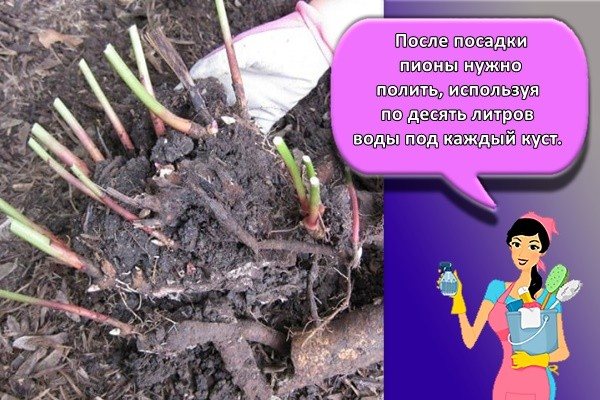

Preparing a landing site
12-14 days (this applies to any soil composition) before the planned landing, we begin to arrange the site.
A pit with a diameter of 60 cm is suitable for any soil, but its depth for owners of heavy soils is 70 cm, for light soils - 50 cm.
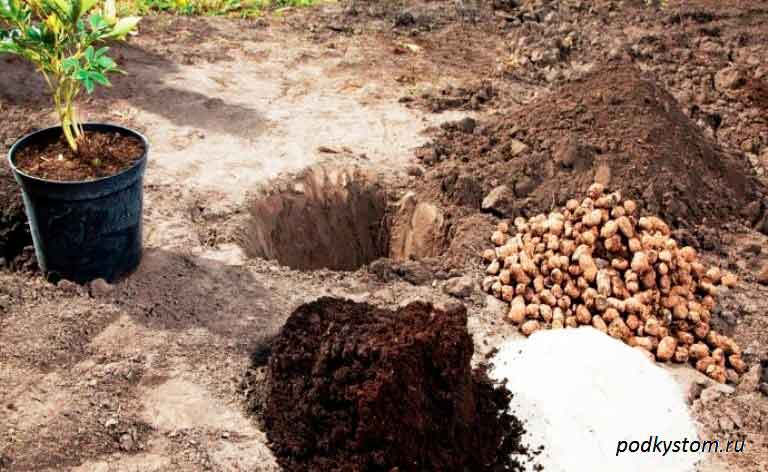

Following this, we will definitely organize good drainage (for example, gravel, pebbles, etc.), fill in a layer of 20 cm.Having finished with this, we bring in humus, compost. We also send there 300 g of wood ash, 100 g of fluff lime, potassium sulfate, 200 g of superphosphate. All this, of course, must be mixed well before being sent to the pit.
We fill the top of the hole with a previously dug soil with a layer of about 20 cm, but always mixed with humus or compost (equal shares). This composition is used for powdering the roots of the resulting divisions, which, when planting, we shake a little so that the soil fills all the voids. Then we tamp it.
We keep a distance when planting plants from 80 to 120 cm.
Landing completed. After its completion, the buds should not be buried below 3-5 cm from the surface. Delenka care, lower than necessary, can be the main reason for the subsequent poor flowering, and what is even worse, even lead to its absence.
Plant care
The very first winter passes with the obligatory cover with sawdust or peat with a layer of no more than 15 cm.With the arrival of springtime, we rake everything up. But you can leave a little peat or other organic matter that served as a shelter for use as a bedding.
For the first two years, we will be sure to pinch the emerging buds.
The main actions associated with leaving are loosening, watering, destruction of unnecessary vegetation.
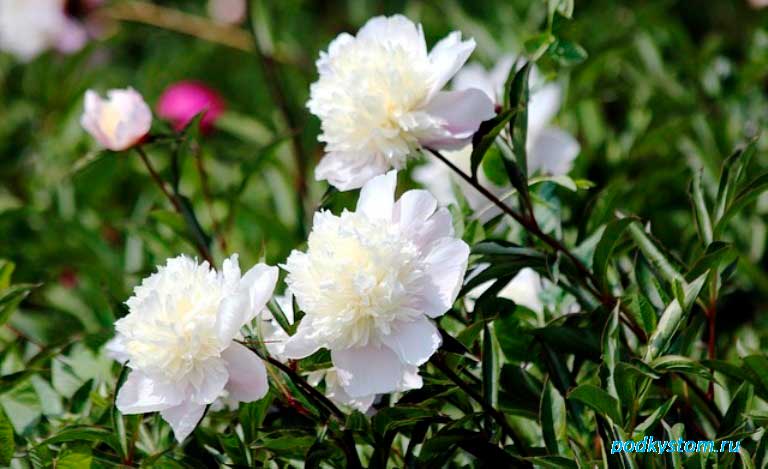

In the presence of dry weather, water until July, which contributes to the formation of full-fledged renewal buds. Further watering is carried out at the end of August - September 2-3 times for a good growth of young adventitious roots. As you can see, watering is rare, but abundant (m2 - 40 l) with a good saturation of soil moisture to the depth of the roots. Watering is carried out in the evening in warm weather.
How we feed our beauties
Many are supporters of not giving any feed in the first year. But, if you think differently or are ready to feed them in their first year, then read on.
We carry out top dressing with organic matter.
- For example, in the spring, when growth begins (May), we feed 2 tablespoons of Agricola-Fantasy fertilizer - 10 liters of liquid.
- On the 15th of June: 10 l - 2 tablespoons "Ideal".
- With the arrival of September: 10 liters of water - a tablespoon of superphosphate and potassium sulfate. On a bush - 3 liters.
- 2-3 times during the summer we spray 10-15 g on the leaves with the preparation "Bud" per 10 liters.
With the onset of the second year, we are deploying food, which peonies (especially organics) love so much.
- In the spring, every year we pay attention to mulching, adding compost / humus / or floral composition ("Rose", "Saintpaulia", "Azalea", etc.) under the bush. The 10 l bucket is enough.
- Mineral fertilizers are also our helpers. In the spring we choose one thing: a tablespoon of urea / 2 tablespoons of "Ideal" / 2 tablespoons of fertilizer "Agricola Rose" (granules) - 10 liters. Spill until budding.
- Time for budding -10 l - 2 tablespoons of nitrophoska, 1 liter of mushy mullein, if not, then 2 tablespoons of Agricola for flowering plants. On a bush - 6-7 liters.
- 10 g of growth stimulant "Bud" per 10 liters will be used for spraying at the moment of bud formation. Scatter 1-2 cups of wood ash around the bush.
- August - the last feeding: 10 liters - a tablespoon of superphosphate, potassium sulfate, micronutrient fertilizer "Agricola for flowering plants". It takes 5-6 liters per culture.
Disease and pest control
For peonies, the most terrible and dangerous disease is gray rot. To avoid the risk of developing this disease, it is necessary in the spring, when shoots are formed on the plant, spray them with copper oxychloride or Bordeaux solution. The preventive course consists of three procedures that are carried out every 10 days.


In addition, the flower crop can become rusty. To prevent the development of the disease during the period of foliage growth, the plant will need to be sprayed with colloidal sulfur.
As for insect pests, peonies are often invaded by ants and bronze beetles, which feed on the buds and shoots of the culture. You can get rid of annoying insects with the help of special insecticides.
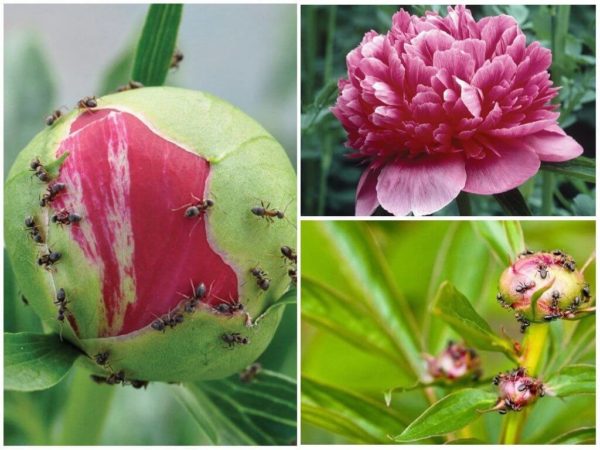

Even a beginner in this business can take care of peonies in the spring in the country. The main thing is to be able to properly prune and transplant shrubs, apply useful fertilizers at the right time and water. All this will help to achieve a beautiful and lush flowering over a long period of time.
Below is a video showing how to care for peonies in spring.
Taking care of flowers
Flowers differ in a variety of shapes and colors, ranging from red to pale pink with a creamy heart.
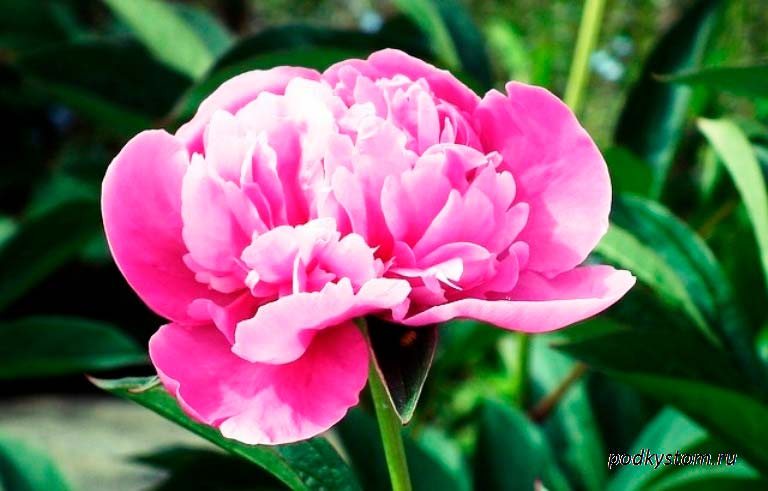

As a rule, the culture begins to bloom from the 3rd year. The length of flowering of the bush reaches two weeks with the spread of an unforgettable aroma. In a dry, sultry summer, it blooms earlier, but fades much faster.
Many varieties have amazingly voluminous caps that often lodge, especially after heavy rainfall. Therefore, the bushes need to organize props.
To obtain flowers of excellent quality from the 3rd year, we stepchild the culture as follows. We keep only one central bud on the stem, but we eliminate the lateral ones.
- We also get rid of faded buds, because petals scattered on the ground can lead to the development of gray rot.
- With the arrival of persistent frosts, we cut the stems, leaving stumps above the buds 2-3 cm high.
- For the winter, we mulch with peat or compost. We do not use straw or foliage to avoid diseases.
To collect a magnificent bouquet, it is better to cut flowers in the morning in dry weather. But completing it, you do not need to get carried away, shredding the bush completely. There should be at least as many stems left on the plant as it was cut off. If you cut it more tightly, then there will be nowhere for new flower buds to emerge, which can significantly worsen flowering for the next season.
We collect plants with dense double flowers in a bouquet only when the lower row of petals opens. If you start this earlier, the buds will not open or will open with inhibition, and then they will completely crumble so quickly that you will not have time to blink an eye.
The beauty of culture, unfortunately, does not protect it from pests and disease attacks.
First watering
When the frost ends and the soil warms up normally, the peonies must be moistened. The first spring watering is carried out with a weak manganese solution. A bucket of water will require five grams of the substance. This amount is enough to moisten three shrubs.
You may be interested in: When to trim a thuja (autumn or spring) and how to do it correctly?
Manganese solution serves as a prophylactic agent against the formation of gray rot on the plant, as well as for disinfecting the substrate in which the flowers are cultivated.
The next watering can be done with plain clean water. You need to apply the liquid directly under the root of the plant.
Note! As soon as warm spring days come, you need to water the peonies abundantly so that the plant can bloom luxuriantly. Also, at this time, buds are beginning to form, in this regard, the culture should not feel a lack of moisture.
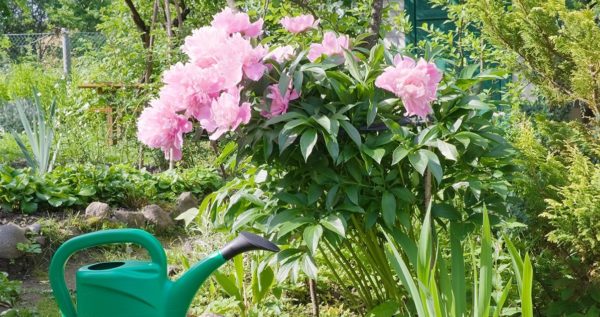

What culture hurts
The main invader, most often appearing on plants growing on damp, acidic clay soils, as well as with an excess of nitrogen, is gray rot (botrytis). But this is just one of a long list of possible ailments. Stem and brown rot, rust, leaf spot, powdery mildew, root decay - as we can see, a rather extensive list.
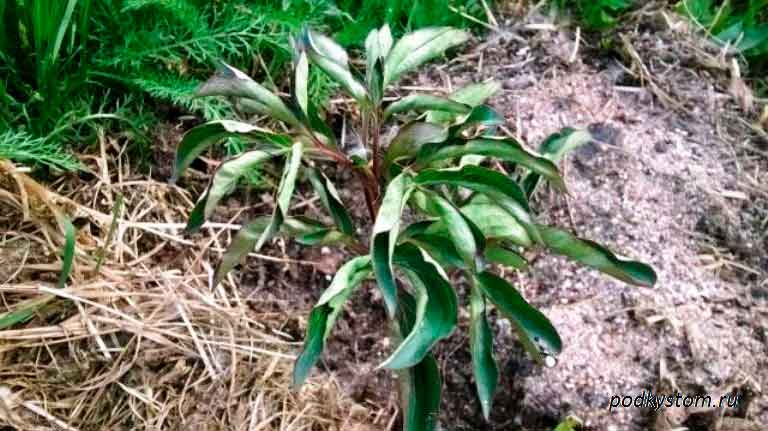

How we fight.
- Once at the very beginning of spring or deep in autumn, we are processing 100 g of copper sulfate, diluted in 10 liters of liquid.
- When planting peonies, we moisten the rhizome cuttings in the composition of 2 Heteroauxin tablets, dissolved in 10 liters.
- 40 g of the preparation "Sulfur colloidal" - 7 liters will go to fight by spraying to get rid of powdery mildew.
- We fight back rust by spraying with 4 ml of Topaz or 100 g of Bordeaux mixture - 10 l of liquid.
It is advisable to carry out spraying activities before and after flowering.
Peony transplant
These amazing colors do not need replanting. But if you nevertheless decide to move them to another place, then it is advisable to do this in the first 2-4 years of the life of the shrubs. The more mature the culture, the more difficult it will be to extract its root.
Sometimes a transplant is necessary due to overgrowth of shrubs and a lack of space. If the plant suddenly began to develop poorly, became weak, poor flowering - this may be a sign of soil depletion. In such cases, replanting or enriching the soil with fresh soil is also recommended.
Peonies are transplanted in the fall, after flowering. A new place is being prepared for them in advance. The holes for transplanting will have to be made deeper, since the roots of an adult bush have already grown significantly. Peonies are dug out carefully, being careful not to damage their root system. If rotting or dried roots are found, they must be removed. If everything went well, then over the winter the bushes will take root in a new place by next spring they will begin to bloom profusely.


